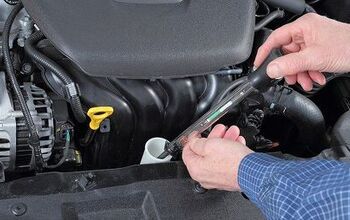The Best Compression Testers to Keep Your Engine Performing Properly
Despite how complex many modern vehicles are, you can do many common repair and maintenance jobs yourself even if you only own basic tools and have limited experience working on your own vehicle. More importantly, you can also easily diagnose issues with vehicle systems like the brakes and suspension because what you see is what you get, whether it’s worn brake pads, a broken spring, or a leaking shock absorber. Things get more complicated when you suspect something is amiss inside your vehicle’s engine and is causing it to perform poorly.
The most surefire route to finding the source of an engine issue is to tear it down so that you can see its internal components. However, that is a complicated job that you should not do without some previous experience. Thankfully, there is an easier way you can diagnose engine internal issues: with an engine compression tester. This is an affordable tool that is easy to use and can tell you a lot about the state of your engine’s pistons and valves—the key parts that make your engine run.
Read on for our picks for the best compression testers you can buy to test your engine’s compression and begin the process of figuring out why it isn’t running the way it should.
For more information on the best compression testers, refer to our table of contents.
Table of contents
- 1. Editor’s Pick: BlueDriver Compression Tester Kit
- 2. Best Basic Compression Tester: INNOVA Compression Tester
- 3. Most Comprehensive Kit: OTC Compression Tester Kit
- 4. JIFETOR Compression Tester Kit
- 5. Lang Tools Compression Tester Set
- 6. Mityvac Professional Compression Tester Kit
- 7. BETOOLL Compression Tester Kit
- 8. J&R Quality Tools Compression Tester
- 9. OTC Cylinder Leakage Tester
- 10. Lang Tools Cylinder Leakage Tester
- Why is compression important in your car’s engine?
- Why do you need to test your engine’s compression?
- What’s the difference between compression testing and leakdown testing?
- What should you do if you determine your engine has poor compression or fails to hold pressure in a leakdown test?
1. Editor’s Pick: BlueDriver Compression Tester Kit
Lemur Vehicle Monitors’ makes this comprehensive compression tester kit, which it markets under its BlueDriver brand of tools. At first glance, this is a solid-looking kit that appears fit for professional use and only gets better upon closer inspection.
Inside a rigid plastic case is an eight-piece kit to let you test the compression on almost any kind of gasoline engine you can think of. The 2.5-inch gauge is marked with three scales—0 to 300 PSI; 0 to 21 kg/cm2; and 0 to 20 bar so that you can work in your preferred unit of measurement. The gauge also includes a pressure release valve and connects to a 16-inch rubber hose.
Then, there are four adapters that let you attach the tester to spark plug ports measuring 10, 12, 14, and 18 mm. The final pieces are two universal direct shafts, one that’s straight and another that’s angled.
Each item has its place in a foam tray that fits snugly in the case to protect the compression tester in case you drop it or have to transport it. The tray is removable, too.
Pros | Hard case with foam tray protects the tester from damage, can be used on almost any gasoline engine |
Cons | Some buyers say the adapters don’t tighten well enough to the tester and can get stuck in the cylinder head, others complain the seal around the plug hole adapter is not well-made |
2. Best Basic Compression Tester: INNOVA Compression Tester
Our top recommendation for a basic engine compression tester is this simple kit from INNOVA. While the INNOVA 3612 is a basic set, it contains all you’ll need to easily check your engine’s compression. It has a 15-inch hose, a gauge that reads to 300 PSI, and 12- 14- and 18-mm adapters you can use on a variety of engine types, including cars, SUVs, motorcycles, snowmobiles, boats, and ATVs.
The gauge face is color-coded with red to indicate low compression, and green to show a higher reading. A 2.5-inch diameter gauge makes it easy for you to read at a glance. There’s also a release valve to bleed accumulated pressure before you unscrew the tester from your engine’s spark plug hole. A quick-disconnect fitting makes INNOVA’s product it quick and easy to use.
INNOVA relies on tried and tested Bourdon tube meter movement to display compression readings, so you can rely on this tester’s accuracy. The rubber hose is oil and grease resistant, making it well-suited to use in a grimy vehicle engine bay.
Pros | Just the basics, simple and proven mechanical gauge movement |
Cons | Doesn’t include a storage case, some buyers say the adapters are too long for certain types of small engines |
3. Most Comprehensive Kit: OTC Compression Tester Kit
From OTC comes a near-professional looking compression tester that promises to let you diagnose performance problems in almost any type of gasoline-powered vehicle or device. At the heart of OTC’s pressure tester is a 2.5-inch gauge that reads from 0 to 300 PSI and 0 to 2,100 kPa, allowing you to check your engine’s compression in whichever unit you’re more familiar with. The gauge also features a pressure release valve and a rubber outer boot to protect the delicate gauge from damage.
To the gauge, you can connect a 25-inch flex hose—one of the longest of any of the kits we’ve included here—with a 14-mm fitting on the end. OTC also includes 10-, 12- and 18-mm adapters so you can use its compression tester on a wide variety of engines, including those with both tapered and flat spark plug seats.
All of those items fit inside a hard case with a designated spot for each part and a removable lid. The kit also includes spare o-rings and Schrader valves for the threaded spark plug fittings, saving you from having to source replacements for these wear items elsewhere.
Pros | Hard case keeps all parts nicely organized, long hose makes for an easy reach in any engine bay |
Cons | Some buyers say the o-ring meant to seal to the spark plug hole does not hold pressure, adapters are too large to reach the spark plug holes in some vehicles |
4. JIFETOR Compression Tester Kit
JIFETOR says its eight-piece engine compression tester is designed for use on any gasoline car or motorcycle engine and includes some useful components that we think will make this kit easier for you to use. Like the other kits we’ve included here, JIFETOR’s has four sizes of threaded spark plug hole adapters measuring 10, 12, 14, and 18 mm in diameter. That means you should be able to thread this tester into almost any gas engine. You also get a three-inch dial that measures 300 PSI and 20 bar and is protected with a rubber cover.
But what we really like about this kit is that it includes a pair of rigid push-on connectors. These are useful on engines where the spark plugs are located at the bottom of deep wells, as they often are on modern dual overhead cam engines, that make it impossible to thread on a flexible hose.
That said, JIFETOR includes a 16-inch flex hose too that you can use on engines that offer more space. All of this kit’s components fit into a rigid orange case.
Pros | 3” gauge face is larger than most for easy reading, push-on fittings for use in tight spaces, seller offers good customer service |
Cons | No kPa scale on the gauge, case lacks a foam insert to protect tool when not in use |
5. Lang Tools Compression Tester Set
Lang Tools makes our list of engine compression testers with a kit that would look perfectly at home in any professional vehicle repair shop. Lang’s setup is built around a 2.5-inch gauge that reads from 0 to 300 PSI and 0 to 21 bar, and features a pressure release valve and a rubber protective bezel. A quick-release connector plugs into the kit’s four flexible rubber hoses.
There are two to fit 14-mm diameter spark plug holes, one with short threads and another with a longer threaded fitting. There’s also a flex hose with an 18-mm fitting and an 18-mm solid hose you can use for engines with deep spark plug wells. The set also includes adapters for 12- and 14-mm spark plug holes. Finally, you also get a small-engine tester for use on lawnmowers and snowblowers that consists of a flex hose with a gauge built into the end.
This eight-piece kit is packaged in a grey plastic clamshell case that holds everything securely in its place and also comes with replacement Schrader valves and o-rings.
Pros | Fittings are made in the U.S., includes a small engine tester, threaded rigid long-reach fitting |
Cons | Expensive, some buyers say they receive a similar-looking product bearing a different brand name, gauge is not made in the U.S. |
6. Mityvac Professional Compression Tester Kit
The Mityvac 5530 is a multi-piece compression testing kit that the company says it designed to work on virtually any gasoline engine. Inside a compact hard black case, you’ll find a 2.75-inch gauge marked in four different scales—bar, PSI, kPa, and kg/cm2—to let you work in the unit of your choice. Like most of the testers in this list, Mityvac’s gauge reads to a maximum of 300 PSI, 20.7 bar, 21.1 kg/cm2, and 2,068 kPa. The gauge uses a reliable Bourdon tube movement with a pressure release valve and sports a rubber housing to give you extra grip and provide impact protection.
The kit also includes a 15-inch flexible hose with 14- and 18-mm adapters and a 14-mm long-thread adapter, all of which you can attach to the gauge with quick-release couplings. Mityvac says that the selection of connectors should fit both car engines and those in lawnmowers, chain saws, and grass trimmers.
Mityvac’s compression tester is unique in this list for including an air-hold adapter that you can use to effect valve seal repairs without having to remove the engine’s cylinder head.
Pros | Includes air-hold fitting to help with valve seal repairs, comes with replacement Schrader valves and o-ring seals |
Cons | No rigid hose for engines with deep spark plug wells, multi-scale gauge can be hard to read at a glance |
7. BETOOLL Compression Tester Kit
The automotive repair tool specialists at BETOOLL make our list of the best compression testers with this eight-piece kit. This is among the most versatile kits on our list. For one, the gauge provides readings in PSI (0 to 300), kg/cm2 (0 to 21), and bar (0 to 20), which, on this gauge, is equivalent to 0 to 2,000 kPa.
A 16-inch rubber hose connects to the gauge with a quick release fitting. To the other end, you can attach your choice of 10-, 12-, 14- or 18-mm threaded fittings, giving you the flexibility to diagnose almost any gasoline engine. All of the fittings are made of corrosion-resistant brass, promising you a long service life.
For engines with deep spark plug wells that make it challenging to tighten a threaded fitting, BETOOLL includes two rigid hoses—one straight, at 6.2 inches, and one angled— with rubber ends that you can simply press against the spark plug hole.
All of this comes packaged in a hard plastic case with a foam insert that keeps all of the kit’s pieces nicely organized.
Pros | Rigid press-on hoses for engines that are tight on space, handy storage case, large gauge dial |
Cons | No soft gauge housing for bump protection, versatile, but may contain more parts than the average DIY mechanic needs |
8. J&R Quality Tools Compression Tester
From J&R Quality Tools comes one of the most straightforward products in this list, and an excellent choice if you’re a budding home mechanic just starting to explore the world of DIY auto repair. J&R has distilled the engine compression tester to its base necessities with a three-piece kit that includes a compression gauge with a 13-inch flexible hose, and 14- and 18-mm spark plug hole adapters. The adapters use quick-release fittings so you can easily swap them out for use on different engines.
The gauge has a 2.5-inch face that’s calibrated for readings in PSI and kPa; its measurement range 0 to 300 PSI or 2,000 kPa. Each scale is color-coded to make it easier for you to read in the unit of your choice.
While we like this product for what it is, we recommend that you make sure it’s well-suited to your needs: the shorter-than-average hose means it will work best if all of the spark plug holes on your vehicle’s engine are easily accessible; and the lack of a rigid hose attachment means it won’t work easily if your car’s engine has deep spark plug wells.
Pros | A simple, inexpensive tool, quality construction, includes instructions |
Cons | No storage case, shorter hose than other kits, no rigid hose for deep spark plug wells |
9. OTC Cylinder Leakage Tester
OTC makes our list for the second time with a tool designed for cylinder leakdown testing, which complements compression testing in engine diagnostic procedures. This tool allows you to feed compressed air into your engine’s combustion chambers to see how well it holds that pressure over a period of time.
Many of the components here overlap with compression testers. You get a 24-inch flexible hose and spark plug hole adapters in 10-, 12-, 14- and 18-mm sizes. You will notice that this product has two 2.5-inch gauges, which allows you to see how much pressure you have applied to your engine and how much pressure your engine is able to hold: the smaller the difference between the gauge readings, the better shape your engine is in. Both gauges are calibrated for readings up to 100 PSI or 700 kPa.
The gauges have chrome bezels for a quality appearance, while protective boots help keep the gauges’ internal components safe from bumps and shocks. You can store all of this kit’s components in a molded plastic case to keep it well organized whether you keep it in your garage or in your vehicle as part of a mobile diagnostics setup.
Pros | An accessibly priced addition to your garage, a useful tool that complements a compression tester |
Cons | You also need an air compressor to use this tool, some owners say build quality is variable and the product needs minor modifications to work optimally |
10. Lang Tools Cylinder Leakage Tester
Lang Tools also makes its second appearance here with a cylinder leakdown tester. At first glance, Lang seems to take a similar approach as OTC with its dual-gauge setup, but this one works a bit differently. While both gauges on OTC’s leakage tester measure air pressure, the right-hand dial on Lang’s tool instead shows you the rate of leakage.
Lang’s pressure gauge reads in PSI (0 to 100) and kPa (0 to 7,000), while the leakage rate dial shows you the leakage rate as a percentage along with green (low), yellow (moderate), and red (high) leakage rates. Both dials measure 2.5-inch in diameter. The idea is to allow you to monitor how much pressure you’re applying to your engine with the pressure dial while using the other to get an idea of the condition of your engine’s internal components.
The dual-dial setup comes with a 26-inch flexible rubber hose to provide useful reach into your vehicle’s engine bay. There are also two 14-mm adapters, one on a standard-reach hose and the other attached a solid, long-reach attachment that you can use for engines whose spark plug holes are difficult to reach by hand.
Pros | Leakage rate gauge takes some of the guesswork out of engine diagnostics, solid adapter for hard-to-reach spark plug holes |
Cons | Comes with a storage box, but buyers say it is not large enough to easily fit the tool into, some buyers reported receiving kits that were missing parts |
Why is compression important in your car’s engine?
Photo credit: BELL KA PANG / Shutterstock.com
Compression is an integral ingredient in the operation of your vehicle’s internal combustion engine.
Your engine works on a four-stroke cycle: intake, compression, expansion/power, and exhaust. The intake cycle is where the intake valves open and the piston travels downward to pull in fuel that is injected along with fresh air. Then, the intake valve closes and the piston travels up to the top of its stroke.
As it reaches the top, the spark plug fires and ignites the mixture of air and fuel, which forces the piston back down for its expansion (or power) stroke. As the piston reaches the bottom of its power stroke, the exhaust valves open and the piston moves up again and forces the burned fuel out of the engine and into the exhaust system.
Any flaws in your engine’s ability to make or hold compression can cause it to run poorly or generate less power than it should. Other problems that can be related to poor compression are excessive oil consumption and increased pollution caused by burned fuel that is allowed to bypass the exhaust system.
Why do you need to test your engine’s compression?
As long as your car’s engine runs well and performs as it should, you don’t need to test its compression. However, if you notice a reduction in performance, such as a lack of power or a drop in fuel economy, or the engine fails to start, then a compression test can reveal the source of the problem, or at least tell you where to start looking to make a diagnosis.
If, during the course of regular maintenance, you notice issues like milky engine oil or discolored coolant, that could point to a failed head gasket, a diagnosis you might more easily make by doing a leakdown test.
What’s the difference between compression testing and leakdown testing?
Compression testing is done by removing all of the engine’s spark plugs and disabling the fuel pump, attaching the tester to each of the spark plug holes in turn and then cranking the engine. The tester will give you a reading that will show you how much compression each cylinder is creating.
By comparison, you conduct a leakdown test by removing just one spark plug and connecting the tester to that spark plug hole. Then you must turn the engine manually so that the cylinder you want to test is at “top dead center” on its compression stroke, which means both intake and exhaust valves will be closed. You use the test tool to inject compressed air into the cylinder, and the tester’s dials will tell you how quickly the air leaks out of that cylinder.
Typically, you would use a compression tester if you suspected problems with your engine’s valve timing or piston movement, or any other issue related to how your engine operates. Leakdown testing is better for testing your engine’s piston rings, its head gasket(s), and valve sealing.
What should you do if you determine your engine has poor compression or fails to hold pressure in a leakdown test?
If your diagnosis shows either low compression or poor leakdown performance due to a worn-out engine, you have a couple of options. The most straightforward one is to sell or trade in the car for a newer model.
Another is to rebuild the engine. This requires you to remove it from the vehicle and take it apart so that you can replace the worn internal parts you suspect are the source of the engine’s poor performance. This is a serious job for which you need either specialized skills or enough time and patience that you can teach yourself to do it correctly. A professional mechanic can do it for you, but it is a costly job that may not make sense financially compared to buying a newer vehicle.
We are committed to finding, researching, and recommending the best products. We earn commissions from purchases you make using the retail links in our product reviews. Learn more about how this works.
Main photo credit: BonNontawat / Shutterstock.com
More by Chris Chase











































Comments
Join the conversation